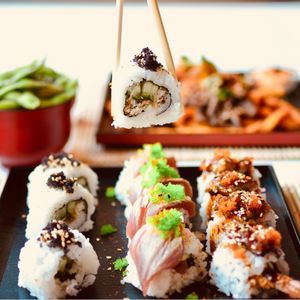Sushi is peaking in popularity and many of the sushi regulars are familiar with most rolls out there. However, those with a newfound interest in sushi may read your menu and don't know where to start their journey of discovering their favorite roll. To help navigate your new sushi guests in the right direction of becoming the ultimate a-fish-onados, read our detailed guide on the most popular sushi rolls and their ingredients.
What Is Sushi?
Sushi is a traditional Japanese dish prepared with vinegared rice that is usually seasoned with salt and sugar. It is paired with ingredients like vegetables, fruits, and seafood which could be raw or cooked. The dish originates from narezushi which over time has become the modern “sushi” we know today. It’s important to note the spelling transformation of the cuisine as it’s common to see them labeled differently on the menus of various sushi restaurants.
While most people automatically correlate sushi with the seafood portion
of the dish, the main characteristic that makes sushi is rice. The word
“sushi” describes the specific method by which the rice is prepared.
Plates that are similar but don’t involve rice aren’t considered sushi.
Sashimi consists of just thinly sliced fish or seafood served alone. It
is often organized in the same category but its lack of rice
disqualifies it from the sushi grouping.
What Types Of Sushi Are There?
Choosing the right roll based on the ingredients is the ultimate personality quiz — the same goes for the form of the sushi. While the sushi found in grocery store fridges are usually rolls, sushi bars and restaurants will normally have a larger variety based on the six main types of sushi.
Nigirizushi “Gripped Sushi”
Often hand-shaped as an elongated rectangular or oval, Nigirisushi is rice topped with a slice of fish or seafood. The top-layer protein is usually raw but can be fermented or cooked in the case of eel and shrimp. Nigiri is usually served in quantities of two ranging from six to 12 pieces, depending on the establishment and dining hour.
Makizushi “Rolled Sushi”
Shaped like a tube, Makizushi or maki, has its filling wrapped in rice. It is held together by a sheet of dried seaweed, called nori, and is cut into six to 10 pieces depending on the type of roll. Maki is one of the main forms of sushi at Asian-inspired restaurants and also serves as a foundation for the following types of sushi:
- Uramaki “inside out roll” - Similar to maki but the filling is wrapped in seaweed then wrapped in rice. These rolls could often be seen topped with thin strips of seafood, veggies, or fruits.
- Hosomaki “thin roll” - Like a maki roll but smaller in diameter. Nori holds together a filling of rice and just one ingredient like salmon or cucumber.
- Gunkan-maki “battleship roll” - A variant of maki, this roll is a hand-shaped rice mound wrapped with a strip of nori seaweed extending over the rice, creating a bowl that holds the topping.
-
Temaki “hand roll” - A similar concept to maki, minus
the shape. Nori is loosely rolled into a cone shape, filled with rice
and other fillings like a sushi ice cream cone.

Commonly Used Seafood For Sushi
The kind of seafood chosen to add in or on top of sushi makes all the difference. The fish should be fresh and safe to eat while also complementing the other ingredients in the roll. Depending on the taste, color, or texture of the preferred meat, there are many options to best match every sushi roll flavor combination such as:
- Salmon
- Tuna
- Ahi tuna
- Halibut
- Squid
- Octopus
- Japanese mackerel
- Yellowtail
10 Most Popular Sushi Rolls
 Some restaurants take inspiration from cities or cultures to
create signature rolls. Whether your customers prefer a simple option or
dare to be adventurous, below are the most popular sushi rolls that you
can add to your menu:
Some restaurants take inspiration from cities or cultures to
create signature rolls. Whether your customers prefer a simple option or
dare to be adventurous, below are the most popular sushi rolls that you
can add to your menu:
- Spicy tuna roll - Tuna, spicy mayo
- Spicy salmon roll - Salmon, Sriracha, spicy mayo
- Dragon roll - Eel, crab sticks, avocado, cucumber
- California roll - Crab/imitation, avocado, cucumber
- Philadelphia roll - Salmon, avocado, cream cheese
- Alaska roll - Smoked salmon, avocado, cucumber, asparagus
- Spider roll - Tempura soft-shell crab, avocado, cucumber, spicy mayo
- Rainbow roll - Crab, tuna, salmon, shrimp, yellowtail, avocado, cucumber
- Tiger (shrimp tempura) roll - Shrimp tempura, cucumber, avocado, eel sauce
- Dynamite roll - Yellowtail, shrimp tempura, bean sprouts, carrots, avocado, cucumber, chili, spicy mayo
Exotic Sushi
As sushi becomes more and more popular, sushi chefs and restaurants are coming up with new ways to present their sushi. From changing the traditional shape or switching the type of taste from savory to sweet, these innovative takes on sushi open up the menu to those who aren’t as keen on the raw seafood dish. Below are inventive ways professional and amateur chefs have changed the game for sushi:
- Mosaic sushi - Roll in the art. Usually made in a square shape, fillings are precisely placed to create a mosaic design within the sushi roll.
- Quinoa sushi - A healthy alternative. Replaces the traditional sushi rice for quinoa to make a nutrient-packed sushi roll.
- Marzipan sushi - A sweet way to roll. Fruit wrapped in sweet rice, held together by almond-flavored marzipan.
- Sushirrito - Part sushi, part burrito. These creations include the concept and fillings of sushi but in the form of a burrito.
- Sushi donut - A new, fun take on sushi. Sushi rice is molded into a donut shape and topped with usual sushi fillings.
- Fruit sushi (frushi) - Sweet and refreshing rolls. Combination of fruit rolled in sweet rice, sometimes flavored with coconut and vanilla for added sweetness.
Sushi For Days
With seemingly endless options, sushi is a versatile meal for every customer and their preferences or dietary restrictions. From hot to cold, rolls to cones, raw or cooked, sushi is a cultural dish that comes in every shape and form to keep guests’ rolls rolling from Philadelphia to California!








